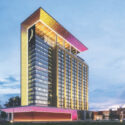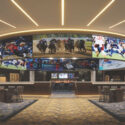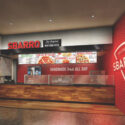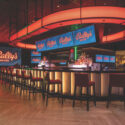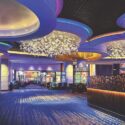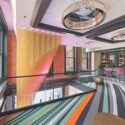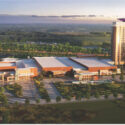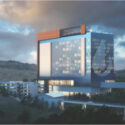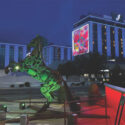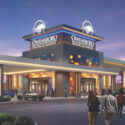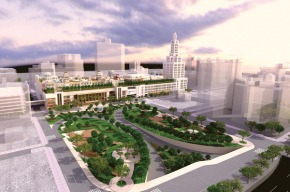
In 2011, when developer Bart Blatstein bought the 18-story offices of the Philadelphia Inquirer newspaper and its tabloid sister, the Philadelphia Daily News, his plan to redevelop the property—as a casino complex, no less—was described in the media as “audacious,” “impudent” and even “an Icarus-like dream.” And rightly so.
The 87-year-old Beaux Arts-style building, with its distinctive clock tower and gold-tipped spire, is one block from Spring Garden Street, considered the border to North Philadelphia—arguably the most distressed neighborhood in town. For many urbanites, this onetime Brahmin bastion is now synonymous with decline and decay. Crime is such a concern that Temple University, in the heart of North Philadelphia, employs the largest university police force in the U.S. (and the third largest armed security force in the state).
What was Blatstein thinking? For answers, it’s helpful to look to another tough Philly neighborhood called Northern Liberties. Since 2000, Blatstein has invested some $100 million around a former Schmidt’s Brewery to create the Piazza, a mixed-use commercial-residential development that has turned “No-Libs” from a shooting gallery into what the Philadelphia Business Journal has called “a sought-after address and destination.”
Destination: Downtown
The idea once was unheard of—casinos as a path to urban renewal. But Philadelphia is just one of a score of U.S. cities turning to gaming halls as a way to revitalize depressed urban cores, add jobs, and not incidentally, stock municipal coffers with fresh tax revenues.
And because these properties are often built on highly developed city blocks, requiring smaller footprints and limiting amenities, they are doing what their Vegas-style predecessors never dreamed of doing: partnering with local restaurants, hotels, spas and the like to create full-scale entertainment cooperatives. In rejecting the monolithic model of old, the urban-casino concept has the potential to truly enliven city centers and prove the truth of the axiom, “A rising tide floats all boats.”
Few states have embraced gaming with as much enthusiasm—or speed—as Ohio. Since May 2012, when the Horseshoe Casino debuted in downtown Cleveland, three additional casinos have opened in the Buckeye State: Hollywood Toledo, Hollywood Columbus and Horseshoe Cincinnati. According to Rock Gaming, which partnered with Caesars Entertainment on the Horseshoe properties, in its first year the Cleveland casino has booked 61,000 room nights for its patrons at local hotels, boosting occupancy by 12.5 percent. And though the casino has several restaurants of its own—including the mandatory buffet—it also directs customers to a dozen eateries outside the casino where they can redeem reward-card points. The reward for restaurant owners: some $2.4 million in business.
“It’s not the mall that killed Main Street and chased all the retailers away,” says Rock CEO Matt Cullen. “It’s very collaborative.”
Unlike casinos of old—the gargantuan “mousetraps” designed to keep patrons inside—the Horseshoe Cleveland hosts summer concerts on an urban plaza, inviting patrons to step outdoors. At Detroit’s Greektown Casino, Rock Gaming—which recently bought a majority stake in the company from Caesars—has plans to occasionally “close down the road and make it a pedestrian mall with bands and activities, which would showcase the adjacent Greek restaurants,” Cullen says.
The approach is in keeping with the new profile of city dwellers, he adds. “If you look at the demographic of who wants to live downtown, it’s young folks and empty nesters. They want the opportunity to walk to a ballgame or a restaurant, take the streetcar to a show, and then go gaming for an hour or so afterward.”
Fitting into the Neighborhood
When planning a city-based casino, “It’s really necessary to be an urban planner of sorts, to try to connect a set of activities unrelated by ownership but related by use,” says architect Paul Steelman, of Steelman Partners in Las Vegas, which is part of Blatstein’s development team in Philadelphia. “We want the casino to become part of the urban structure, not something that sticks out in the urban structure.”
In other words, don’t plop down a mini-Mirage in Chicago, Portland or Podunk. “People say everyone wants the Vegas experience, but you’ve failed as an architect in an urban center if you build something that looks, feels and acts like Vegas,” says Steelman. “There are many ways to create beautiful entertainment-based architecture in almost any style, so wherever you go you can create something in keeping with the urban district that also says, ‘This is a casino.’”
The Empire Casino in London’s Leicester Square is one example: located at the site of the historic Empire Ballroom—once a Victorian music hall, later a lavish movie palace—the city’s largest casino “is a gorgeous piece of architecture done in a handsome, code-conforming way that is the center of entertainment in this district,” Steelman observes.
In fact, though the Empire has seen many additions, subtractions and adds-on over the years, its ornate baroque entryway is almost indistinguishable from the Empire of yore, which actually was mentioned in Oscar Wilde’s 1895 comedy The Importance of Being Earnest.
“The architectural challenge in urban areas is to stand out and fit in at the same time,” says Cullen. “You want to make a statement, you want to have something people look at and say, ‘Wow, very cool,’ but it has to fit in and incorporate a lot of cues from the community you’re in. When we were trying to get sites in Cleveland and Cincinnati, we promised not to give them a Treasure Island with boats shooting out of the water.”
Needless to say, the new “integrated resort”—a catchphrase that describes a property’s interdependence on local businesses—can dispense with many of the old rules for casino design, such as the day-for-night ambiance of dark rooms illuminated by gaudy neon. Design and architecture are “lighter, brighter, airier, with taller ceilings, with more brilliant carpets and more hardwood floors,” says Steelman. “It has a modern palatial effect, which is a key to bringing people back.”
The prairie-wide, contiguous first-level casino floor, once a staple of the casino designer, is now strictly optional, says Steelman.
“Look at the Solaire (in Manila). Technically it’s not one gaming floor, but broken into eight sections with pathways, some half-walls, some ceiling differentials and partial enclosures. That’s how it’s done in Macau, too, and it’s a trend that will be really apparent as we redesign and renovate.”
Retrofit, Recycle, Revive
By choice or necessity, urban casino development is often redevelopment. Blatstein plans to reconstruct and build around a historic newspaper office. The Horseshoe Cleveland was built inside the former Higbee’s department store, a Beaux Arts masterpiece first built in 1931 and later immortalized in Jean Shepherd’s A Christmas Story.
A sterling example of adaptive reuse is Detroit’s Motor City Casino, formerly the Wagner Baking Company, maker of Wonder Bread and Hostess cupcakes. The fortress-like brick structure was built in 1927 by Chicago architect Walter W. Ahlschlager, who also designed the Roxy and Pantages theatres and the famous Peabody Hotel (known for its resident ducks, which parade daily from the penthouse to an outdoor fountain). But by the early 1990s, the building was a warehouse for Goodwill Industries.
“It had been closed as a commercial building for decades, and it was a mess—water in the basement, and packed to the rafters with peoples’ hand-me-downs,” says Motor City CEO Gregg Solomon. “We could have started from scratch somewhere, but we’ve been here long enough to understand what it was that was iconic in the public mind about this building: there’s a big smokestack you can see for miles, and parapets, and the edifices on the corner of Grand River and Temple streets. There were a lot of terra cotta inserts that over the years had fallen off and broken, but we were fortunate enough to find the original blueprints for the building, because we wanted to be fully vested in what Detroit used to be about and what it could be in the future.”
The result, says Solomon, is a “future-retro concept” that took its cues from a line of concept cars designed in the Motor City during in the Post War World War II era of the late 1940s and early 1950s. For a hint of the design aesthetic, think Futurama, a GM-sponsored exhibit that was mounted at the 1939 World’s Fair; Disney’s Tomorrowland, which first opened in 1955; and the Jetsons cartoon series of the 1960s.
“The cars had bubble canopies and tailfins and looked like jet engines, because a moment before, these guys were building aircraft engines for the war effort; now they were working on cars again, and they had had a taste of what they called the aerospace movement,” says Solomon. That Atomic Age influence is evident in the Motor City, which includes futuristic elements like an undulating wave-shaped roofline and countless subtle, almost subliminal nods to Motown’s manufacturing history, such as hubcap-shaped silver upholstery buttons, repeated impressions of a ’57 Cadillac grill in the wallpaper, and bench seating inspired by a Ford Thunderbird. “You would have to be pretty observant to see it,” says Solomon. “Almost nobody ever figures it out.”
But traces of the old bread factory remain, and that’s by design. The brick bullnose of the original Wagner Bakery anchors one corner of the building, with the 17-story tower “paying homage to the grand era of Detroit,” Solomon says.
The project was not without its challenges: the bakery façade had started to tilt out over the street, and “we used steel supports to tie back the whole building,” says Solomon. Lead-painted surfaces had to be removed, as well as underground fuel oil storage tanks. Another problem: asbestos, once used to insulate the hot ovens. “We would open a wall and the next thing you know, you had to clear the whole crew out and bring in the guys in the moon suits, testing to make sure it’s not something bad,” says Solomon. “An old building is a double-edged sword, but it saves a huge amount of energy if you reuse existing materials. We tried to make it as energy-efficient as possible.”
The Grand Victoria riverboat casino in Elgin, Illinois, an MGM Resorts property at the site of the former Elgin Watch Factory, is another example of “designing to the site.” The factory is long gone, but in fitting tribute to its past, the property’s land-based pavilion is characterized by a giant clock hanging from the atrium ceiling. The architecture was inspired by the Craftsman period and the work of Frank Lloyd Wright.
“If you’re going to be in Elgin, be in Elgin,” says Solomon, a veteran of the Las Vegas gaming scene. “If you’re going to be in Tunica, be in Tunica. But don’t try to run a Las Vegas game here. Hey, we’re from Las Vegas, so don’t show us how it’s done. You have to get your wrapped head around what’s cool to the people here, and what they want.”
Some Things Never Change
But not all the old rules are subject to change, says interior designer Floss Barber of Floss Barber Inc. “Gamblers and slot players like certain configurations that aren’t about aesthetics; there are component parts to a casino that a designer knows that direct the flow of the patron, such as an easy entrance with no barriers, the player’s club very close to the entrance so you can capture that person and sign them up, clustered table games so people can jump from one to the other, and a roulette table near the cashier,” so if someone wins big, they may try their luck one more time before cashing out.
The table game area should be intimate and foster camaraderie among players; the slots are more solitary, for players who like to choose a “lucky niche,” Barber says. “It’s the idiosyncrasies of the player that get communicated in the design.”
That said, Barber notes, there is a trend away from grandiosity and toward natural finishes and elements, particularly in the urban casino.
“As we become more digital, people are freaking out; they’re looking for the natural elements of air, space and light, be it in a restaurant, hotel or college space, and it would be natural for it to move into casinos,” she says. If an operator elects to install wood floors to replace the gaudy multicolored carpets that hide so much dirt, they would have to be super-durable to withstand 24-hour traffic with virtually no down time for thorough maintenance.
A trend that may have seen its day, except possibly in Las Vegas, is outrageously themed décor. “I worked many years ago at a casino in Atlantic City where the high-roller suites were designed to look like something out of Julius Caesar and Cleopatra, Marco Polo—all these bizarre fantasies,” says Barber. “The traveling public in general has become much more sophisticated.”
Speaking of Atlantic City, Paul Steelman says casino operators who built there now wish they had never built insular buildings that “walled off the Boardwalk. Now they all say, ‘Why did we do that?’” Steelman says. “Why didn’t we worship the Boardwalk?”
Beyond the Obvious
Casinos have been held up as economic drivers for cities that have seen their downtowns empty out and residents flee to the suburbs. As more people consider returning to the city—those young working adults and older retired people—center-city gaming halls have benefits beyond increased tax revenues, says Rock Gaming’s Cullen.
“Sure, the tax revenue is a big benefit to the community, but if that’s all you’re looking for, you’ve missed out on other opportunities” that may be even more enduring. “We have worked diligently to make sure we emphasize local and WBE and MBE projects,” he says. “We committed that 90 percent of the hires would be from within the metropolitan statistical area in those communities, and thousands of new jobs are being made available. We’re partnering with retailers, partnering with hotels.
“The tax revenue is very important and a huge revenue source in Detroit in and the state of Ohio, but we weren’t gaming guys interested in the revitalization of cities,” he says. “We’re business guys, entrepreneurs and urbanists that happen to be in gaming.”
The list is long of cities that now host the new urban brand of casino, and it is expected to grow. Next year, Rock Gaming and Caesars Entertainment will open the Horseshoe Casino near the Inner Harbor in Baltimore. And a casino could soon be in the works for the Greater Boston area.
Steelman, who is the architect for Blatstein’s Philadelphia casino proposal, says the developer’s “Provence” resort project, if approved by legislators, could turn a couple of dismal city blocks into a Parisian-style thoroughfare and a former newspaper office “into a grand hotel like the Plaza in New York, the Georges V in Paris or the Connaught in London.”
“The whole idea is to take a magic wand, wave it over this area and crack it open,” says Steelman—essentially reconnecting the forsaken community to the lively Center City business district and extending it to Broad Street.
And Steelman, for one, thinks it can happen. Even in North Philly.



